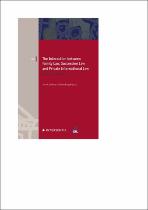| dc.contributor.author | Scherpe, Jens | |
| dc.contributor.author | Bargelli, Elena | |
| dc.date.accessioned | 2022-05-09T08:07:19Z | |
| dc.date.available | 2022-05-09T08:07:19Z | |
| dc.date.issued | 2021 | |
| dc.identifier.citation | Scherpe, Jens (with Elena Bargelli) ‘The interaction between family law, succession law and private international law – Adapting to change: An introduction’ in Jens Scherpe and Elena Bargelli, eds. The interaction between family law, succession law and private international law – Adapting to change (Intersentia, 2021) pp. 1–12 | en_US |
| dc.identifier.uri | https://doi.org/10.1017/9781839701283.001 | |
| dc.identifier.uri | http://hdl.handle.net/10566/7368 | |
| dc.description.abstract | At the national level, the rules of substantive family and succession law work with private international law rules created specifically for these substantive laws. Hence, there cannot be any question that there is an interaction between the substantive family and succession law and private international law and that they significantly influence each other.
However, over the last 20 years, private international law instruments by the European Union (EU) in family law, and more recently also in succession law, have replaced or at least supplemented national private international law instruments. Given that these the instruments are intended to apply to all EU Member States, and thus to jurisdictions with different legal traditions and vastly different approaches to family and succession law, it was inevitable that frictions would arise. | en_US |
| dc.language.iso | en | en_US |
| dc.publisher | Intersentia | en_US |
| dc.subject | Family law | en_US |
| dc.subject | Succession law | en_US |
| dc.subject | Private international law | en_US |
| dc.subject | European Union (EU) | en_US |
| dc.subject | Adapting to change | en_US |
| dc.title | The interaction between family law, succession law and private international law: An introduction | en_US |
| dc.type | Book chapter | en_US |

